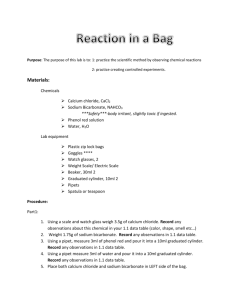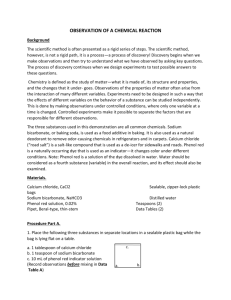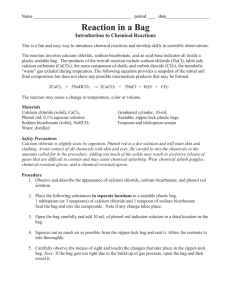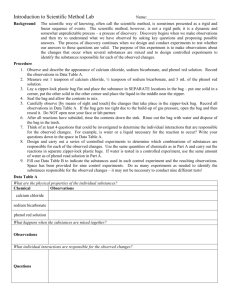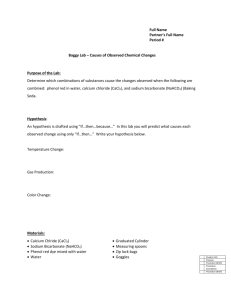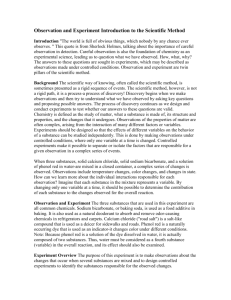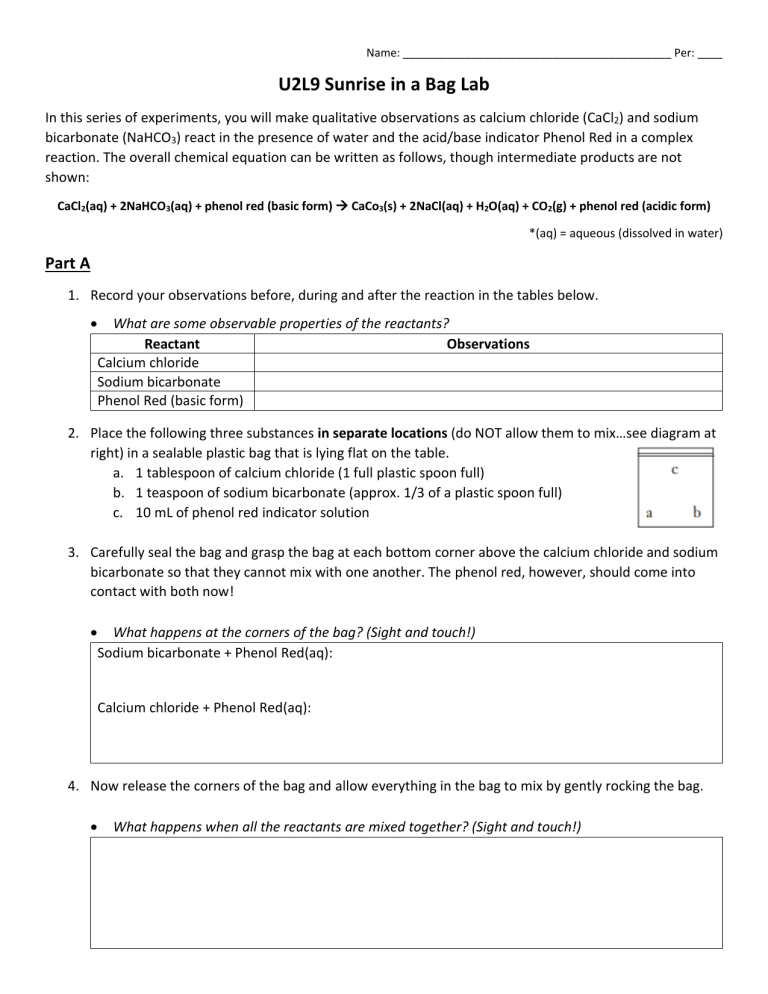
Name: ___________________________________________ Per: ____ U2L9 Sunrise in a Bag Lab In this series of experiments, you will make qualitative observations as calcium chloride (CaCl2) and sodium bicarbonate (NaHCO3) react in the presence of water and the acid/base indicator Phenol Red in a complex reaction. The overall chemical equation can be written as follows, though intermediate products are not shown: CaCl2(aq) + 2NaHCO3(aq) + phenol red (basic form) → CaCo3(s) + 2NaCl(aq) + H2O(aq) + CO2(g) + phenol red (acidic form) *(aq) = aqueous (dissolved in water) Part A 1. Record your observations before, during and after the reaction in the tables below. • What are some observable properties of the reactants? Reactant Observations Calcium chloride Sodium bicarbonate Phenol Red (basic form) 2. Place the following three substances in separate locations (do NOT allow them to mix…see diagram at right) in a sealable plastic bag that is lying flat on the table. a. 1 tablespoon of calcium chloride (1 full plastic spoon full) b. 1 teaspoon of sodium bicarbonate (approx. 1/3 of a plastic spoon full) c. 10 mL of phenol red indicator solution 3. Carefully seal the bag and grasp the bag at each bottom corner above the calcium chloride and sodium bicarbonate so that they cannot mix with one another. The phenol red, however, should come into contact with both now! • What happens at the corners of the bag? (Sight and touch!) Sodium bicarbonate + Phenol Red(aq): Calcium chloride + Phenol Red(aq): 4. Now release the corners of the bag and allow everything in the bag to mix by gently rocking the bag. • What happens when all the reactants are mixed together? (Sight and touch!) • What do the contents of the bag look like after the reaction has completed? 5. Finally, carefully open the bag while making sure that the opening is aimed away from yourself and anyone around you. Allow the bag to remain open and the gas to escape. After about a minute, record your observations below and describe what your observations before and after opening the bag suggest. Part B How can we find out what interactions are responsible for the observed changes?!? 1. After Part A, you should have some questions about what is actually going on in the sealed plastic bag. Formulate at least three questions that still need to be answered after Part A. (Hint: think about the changes you observed) 2. Data Table 1 on the next page will give you some guidance as to which controlled experiments we need to perform in order to better understand what interactions are causing the temperature, gas, and color changes that we observed in Part A. a. Use the same quantities of chemicals as in Part A to carry out the seven controls. b. If water is tested in a controlled experiment, use the same amount of water as of phenol red solution in Part A. c. After each controlled experiment, record your observations in Data Table 1 and indicate whether it was a physical or chemical change (careful!). Data Table 1 Number (Reaction container) Calcium chloride Sodium bicarbonate Phenol red Water Observations Physical or Chemical Change? 1 (small beaker) 2 (ziploc bag) 3 (ziploc bag) 4 (ziploc bag) 5 (ziploc bag) 6 (small beaker) 7 (ziploc bag) Discussion Questions 1. What control experiments were done to evaluate if a liquid is necessary for the observed effects in Part A? Does any reaction occur in the absence of water? 2. Is there any evidence that a new chemical substance is produced in the overall reaction of the four substances mixed in Part A? Explain. What interaction among the four components must be responsible for the new substance? 3. Based on the results of the control experiments, what interaction among the four substances seems to be responsible for the observed temperature change in the overall reaction in Part A? Was this interaction a physical or chemical change? 3. Temperature changes are sometimes used as evidence to indicate that a chemical change/reaction, which produces a new chemical substance, has occurred. Comment on using this observation as an indication of a chemical reaction. Complete the following paragraph explaining what took place in the bag. Use the word bank to help you; not all words will be used! acidic acids bases endothermic exothermic basic chemical change color gas physical change red yellow Calcium chloride produces heat (___________________) when dissolved in water, while sodium bicarbonate absorbs heat (___________________) when dissolved in water. Calcium chloride, baking soda, and water combine to produce carbon dioxide __________. Phenol red is an acid/base indicator that changes __________ in the presence of ___________ and ____________. This change in color indicates a _________________________. Sodium bicarbonate (baking soda) is a base. When it comes into contact with phenol red in its basic (red) form, the phenol red keeps its bright ________ color. As sodium bicarbonate reacts with calcium chloride in water, acidic substances are produced and the phenol red indicator changes from its basic form to its acidic, or __________, form. Carbon dioxide is one of the acids produced—it dissolves in water and reacts to form carbonic acid, H2CO3, which makes the water acidic. (This is also why unflavored, unsweetened sparkling water tastes sour!) If some of this carbon dioxide gas is allowed to escape from the bag, less of it will remain dissolved in water and the water will become less ___________ (more ___________) again and the contents of the bag may turn slightly orange or pink again.

